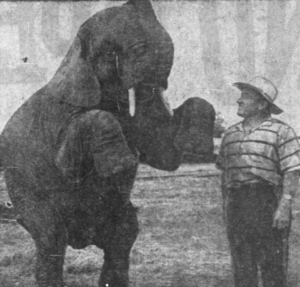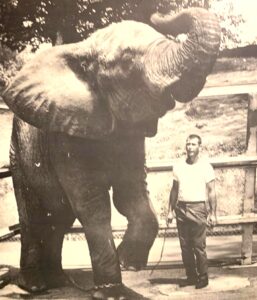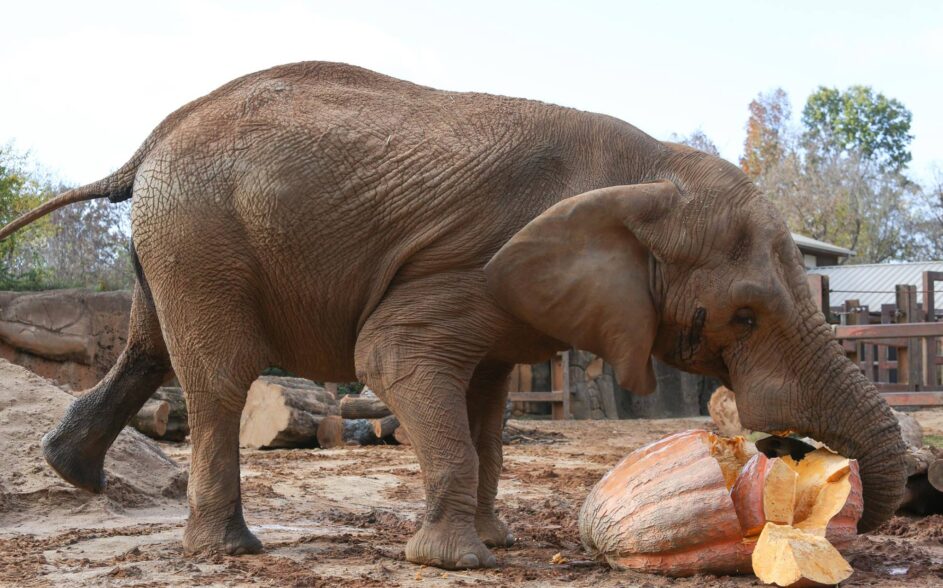Jana moved over the Rainbow Bridge in October. Edie safely arrived at The Elephant Sanctuary in Hohenwald just a few weeks ago. Now Tonka is left as the only elephant in residence at Zoo Knoxville, awaiting his own journey to the sanctuary sometime in spring 2024 once his transport crate and training to use it are complete.
Tonka now holds a space his predecessor once did: he’s the largest African bull elephant in the Northern Hemisphere, he’s living a solo existence and he lives in Knoxville. Tonka arrived in 1981 at the age of 2, a year after Old Diamond died, the star attraction at what was then called the Knoxville Zoo. Like Diamond, Tonka was born wild and captured at roughly one year old. Unlike Diamond, he didn’t have to live through an attempt at becoming a circus animal to get here.

A photo purported to be of Diamond and trainer Hugo Schmitt in 1957 (Photo credit: unknown).
In many ways, Diamond (whether you call him Big, Ol’, Old or his original name, Louie) is the back upon whom the success of Zoo Knoxville rests. Fifty years ago, he’d been here a decade, had no companionship and had a large reputation for being generally cantankerous and tearing up everything around him. I have a very specific memory of visiting the zoo one day in the 1970s, and he was repeatedly charging and head-butting the small cliff that rose at the back of his enclosure. I suppose he was determined to fight something.
Diamond was reportedly born in Kenya or Tanganyika (now part of Tanzania) in 1946 and captured in 1947 by Fred Zeehandelaar and imported to the United States through his International Fertilizer and Chemical Company. The company seems to have had very little to do with fertilizers or chemicals. Known then as Louie, he arrived in Sarasota to join trainer Hugo Schmitt and the other elephants belonging to Ringling Brothers’ and Barnum and Bailey’s Circus.
Schmitt was born on the wrong side of two world wars; the short of it is he found himself a German in exile in Sweden in 1947 with a bunch of elephants in his charge about to be sold as “spoils of war.” Absolutely distraught over the Swedish government’s decision, he turned loose five of his bulls to run riot over the town of Malmö. After disturbing the citizenry and destroying lots of crockery, the elephants were brought back under control and eventually made their way to the U.S. to join the circus.
Diamond’s history with Ringling Brothers began pretty much simultaneously with Schmitt’s and lasted well over a decade. During that time, he was originally known as Little Diamond, and by 1957 was the only African bull elephant performing in any circus anywhere. But as the years went by and Diamond got bigger, he also grew less tractable, as African elephants are wont to do.
So, by 1963, Diamond was given to what was then the Municipal Zoo at Chilhowee Park. He arrived to an operation short on proper accommodations and training for an elephant of his size and temperament, to the point that within three years the city was looking to sell him off elsewhere. The “Save Ole Diamond” campaign grew into a larger effort to improve the zoo overall and secure its future, spearheaded by Guy Smith III. The zoo now is a far cry from what it was in 1970, which, honestly, was mostly sad.

Diamond at the Knoxville Zoo (Photo credit: unknown).
By 1974, Diamond was joined by Sapphire (originally named Hazel), and a year later by Toto. They became the mothers of Hilary and Little Diamond, respectively, the first African elephants born in the western hemisphere. Within 15 years of acquiring Diamond, the zoo turned a dubious (at best) acquisition into a conservation triumph.
As Tonka enters his last days in Knoxville, many wonder if this is the end of Zoo Knoxville’s journey with elephants. Not necessarily so, according to Tina Rolen, director of marketing and communications. For the time being the elephant habitat will be reworked for the rhinoceros population. A new elephant habitat would have to be reimagined, and would likely be several years down the road before it happened. But with community support, there are likely to be elephants at Zoo Knoxville again.
Beth Kinnane writes a history feature for KnoxTNToday.com. It’s published each Tuesday and is one of our best-read features.
Sources: Zoo Knoxville, Knoxville News Sentinel Digital Archives, The Elephant Encyclopedia by Dan Koehl

